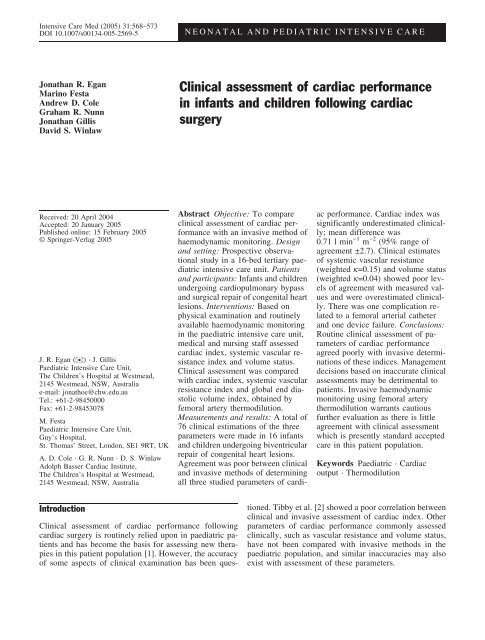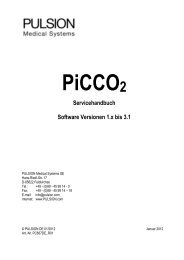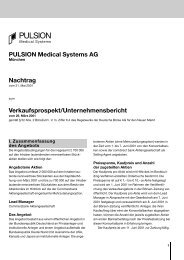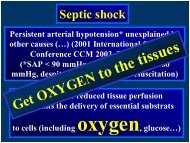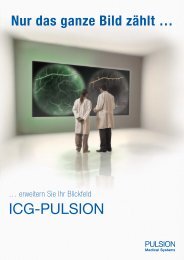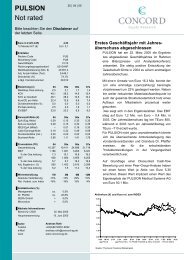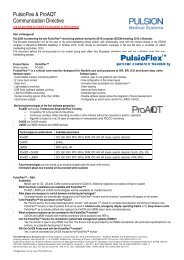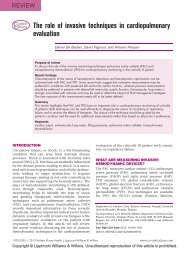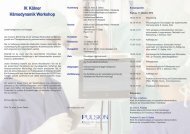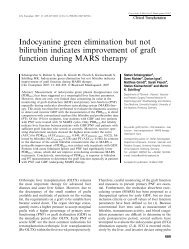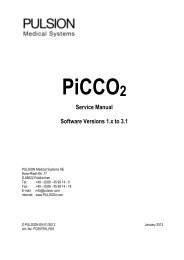Clinical assessment of cardiac performance in infants and children ...
Clinical assessment of cardiac performance in infants and children ...
Clinical assessment of cardiac performance in infants and children ...
You also want an ePaper? Increase the reach of your titles
YUMPU automatically turns print PDFs into web optimized ePapers that Google loves.
Intensive Care Med (2005) 31:568–573<br />
DOI 10.1007/s00134-005-2569-5<br />
NEONATAL AND PEDIATRIC INTENSIVE CARE<br />
Jonathan R. Egan<br />
Mar<strong>in</strong>o Festa<br />
Andrew D. Cole<br />
Graham R. Nunn<br />
Jonathan Gillis<br />
David S. W<strong>in</strong>law<br />
<strong>Cl<strong>in</strong>ical</strong> <strong>assessment</strong> <strong>of</strong> <strong>cardiac</strong> <strong>performance</strong><br />
<strong>in</strong> <strong>in</strong>fants <strong>and</strong> <strong>children</strong> follow<strong>in</strong>g <strong>cardiac</strong><br />
surgery<br />
Received: 20 April 2004<br />
Accepted: 20 January 2005<br />
Published onl<strong>in</strong>e: 15 February 2005<br />
Spr<strong>in</strong>ger-Verlag 2005<br />
J. R. Egan ()) · J. Gillis<br />
Paediatric Intensive Care Unit,<br />
The Children’s Hospital at Westmead,<br />
2145 Westmead, NSW, Australia<br />
e-mail: jonathoe@chw.edu.au<br />
Tel.: +61-2-98450000<br />
Fax: +61-2-98453078<br />
M. Festa<br />
Paediatric Intensive Care Unit,<br />
Guy’s Hospital,<br />
St. Thomas’ Street, London, SE1 9RT, UK<br />
A. D. Cole · G. R. Nunn · D. S. W<strong>in</strong>law<br />
Adolph Basser Cardiac Institute,<br />
The Children’s Hospital at Westmead,<br />
2145 Westmead, NSW, Australia<br />
Abstract Objective: To compare<br />
cl<strong>in</strong>ical <strong>assessment</strong> <strong>of</strong> <strong>cardiac</strong> <strong>performance</strong><br />
with an <strong>in</strong>vasive method <strong>of</strong><br />
haemodynamic monitor<strong>in</strong>g. Design<br />
<strong>and</strong> sett<strong>in</strong>g: Prospective observational<br />
study <strong>in</strong> a 16-bed tertiary paediatric<br />
<strong>in</strong>tensive care unit. Patients<br />
<strong>and</strong> participants: Infants <strong>and</strong> <strong>children</strong><br />
undergo<strong>in</strong>g cardiopulmonary bypass<br />
<strong>and</strong> surgical repair <strong>of</strong> congenital heart<br />
lesions. Interventions: Based on<br />
physical exam<strong>in</strong>ation <strong>and</strong> rout<strong>in</strong>ely<br />
available haemodynamic monitor<strong>in</strong>g<br />
<strong>in</strong> the paediatric <strong>in</strong>tensive care unit,<br />
medical <strong>and</strong> nurs<strong>in</strong>g staff assessed<br />
<strong>cardiac</strong> <strong>in</strong>dex, systemic vascular resistance<br />
<strong>in</strong>dex <strong>and</strong> volume status.<br />
<strong>Cl<strong>in</strong>ical</strong> <strong>assessment</strong> was compared<br />
with <strong>cardiac</strong> <strong>in</strong>dex, systemic vascular<br />
resistance <strong>in</strong>dex <strong>and</strong> global end diastolic<br />
volume <strong>in</strong>dex, obta<strong>in</strong>ed by<br />
femoral artery thermodilution.<br />
Measurements <strong>and</strong> results: A total <strong>of</strong><br />
76 cl<strong>in</strong>ical estimations <strong>of</strong> the three<br />
parameters were made <strong>in</strong> 16 <strong>in</strong>fants<br />
<strong>and</strong> <strong>children</strong> undergo<strong>in</strong>g biventricular<br />
repair <strong>of</strong> congenital heart lesions.<br />
Agreement was poor between cl<strong>in</strong>ical<br />
<strong>and</strong> <strong>in</strong>vasive methods <strong>of</strong> determ<strong>in</strong><strong>in</strong>g<br />
all three studied parameters <strong>of</strong> <strong>cardiac</strong><br />
<strong>performance</strong>. Cardiac <strong>in</strong>dex was<br />
significantly underestimated cl<strong>in</strong>ically;<br />
mean difference was<br />
0.71 l m<strong>in</strong> Ÿ1 m Ÿ2 (95% range <strong>of</strong><br />
agreement €2.7). <strong>Cl<strong>in</strong>ical</strong> estimates<br />
<strong>of</strong> systemic vascular resistance<br />
(weighted k=0.15) <strong>and</strong> volume status<br />
(weighted k=0.04) showed poor levels<br />
<strong>of</strong> agreement with measured values<br />
<strong>and</strong> were overestimated cl<strong>in</strong>ically.<br />
There was one complication related<br />
to a femoral arterial catheter<br />
<strong>and</strong> one device failure. Conclusions:<br />
Rout<strong>in</strong>e cl<strong>in</strong>ical <strong>assessment</strong> <strong>of</strong> parameters<br />
<strong>of</strong> <strong>cardiac</strong> <strong>performance</strong><br />
agreed poorly with <strong>in</strong>vasive determ<strong>in</strong>ations<br />
<strong>of</strong> these <strong>in</strong>dices. Management<br />
decisions based on <strong>in</strong>accurate cl<strong>in</strong>ical<br />
<strong>assessment</strong>s may be detrimental to<br />
patients. Invasive haemodynamic<br />
monitor<strong>in</strong>g us<strong>in</strong>g femoral artery<br />
thermodilution warrants cautious<br />
further evaluation as there is little<br />
agreement with cl<strong>in</strong>ical <strong>assessment</strong><br />
which is presently st<strong>and</strong>ard accepted<br />
care <strong>in</strong> this patient population.<br />
Keywords Paediatric · Cardiac<br />
output · Thermodilution<br />
Introduction<br />
<strong>Cl<strong>in</strong>ical</strong> <strong>assessment</strong> <strong>of</strong> <strong>cardiac</strong> <strong>performance</strong> follow<strong>in</strong>g<br />
<strong>cardiac</strong> surgery is rout<strong>in</strong>ely relied upon <strong>in</strong> paediatric patients<br />
<strong>and</strong> has become the basis for assess<strong>in</strong>g new therapies<br />
<strong>in</strong> this patient population [1]. However, the accuracy<br />
<strong>of</strong> some aspects <strong>of</strong> cl<strong>in</strong>ical exam<strong>in</strong>ation has been questioned.<br />
Tibby et al. [2] showed a poor correlation between<br />
cl<strong>in</strong>ical <strong>and</strong> <strong>in</strong>vasive <strong>assessment</strong> <strong>of</strong> <strong>cardiac</strong> <strong>in</strong>dex. Other<br />
parameters <strong>of</strong> <strong>cardiac</strong> <strong>performance</strong> commonly assessed<br />
cl<strong>in</strong>ically, such as vascular resistance <strong>and</strong> volume status,<br />
have not been compared with <strong>in</strong>vasive methods <strong>in</strong> the<br />
paediatric population, <strong>and</strong> similar <strong>in</strong>accuracies may also<br />
exist with <strong>assessment</strong> <strong>of</strong> these parameters.
569<br />
Despite these concerns about cl<strong>in</strong>ical <strong>assessment</strong> alternative<br />
approaches such as <strong>in</strong>vasive haemodynamic<br />
monitor<strong>in</strong>g with pulmonary or femoral arterial thermodilution<br />
(FATD) are not used widely <strong>in</strong> paediatrics. This<br />
may relate to difficulties with central access, potential<br />
complications or perhaps be due to a lack <strong>of</strong> proven<br />
benefit <strong>in</strong> outcome attributable to their use <strong>in</strong> <strong>children</strong> [3].<br />
Unless <strong>in</strong>vasive haemodynamic monitor<strong>in</strong>g is shown to be<br />
<strong>of</strong> benefit <strong>in</strong> paediatric patients, its use is likely to rema<strong>in</strong><br />
limited. However, outcome studies <strong>and</strong> further <strong>assessment</strong>s<br />
<strong>of</strong> <strong>in</strong>vasive haemodynamic monitor<strong>in</strong>g <strong>in</strong> <strong>children</strong><br />
are warranted only if cl<strong>in</strong>ical <strong>assessment</strong>s <strong>of</strong> <strong>cardiac</strong><br />
<strong>performance</strong> <strong>in</strong> comparison are poor.<br />
To <strong>in</strong>vestigate this we performed an observational<br />
study <strong>of</strong> paediatric patients follow<strong>in</strong>g <strong>cardiac</strong> surgery.<br />
Three commonly assessed parameters <strong>of</strong> <strong>cardiac</strong> <strong>performance</strong><br />
were assessed by two methods. <strong>Cl<strong>in</strong>ical</strong> <strong>assessment</strong><br />
<strong>of</strong> <strong>cardiac</strong> output, volume status <strong>and</strong> systemic vascular<br />
resistance were compared with <strong>in</strong>vasively obta<strong>in</strong>ed<br />
values for these parameters. Our experience with an <strong>in</strong>vasive<br />
form <strong>of</strong> haemodynamic monitor<strong>in</strong>g <strong>in</strong> paediatric<br />
patients was also reported.<br />
Materials <strong>and</strong> methods<br />
Inclusion criteria were weight between 4 <strong>and</strong> 20 kg, an operation<br />
requir<strong>in</strong>g cardiopulmonary bypass to achieve a biventricular repair<br />
<strong>and</strong> normal pre-operative renal function. Informed consent was<br />
obta<strong>in</strong>ed prior to patient enrolment, <strong>and</strong> the ethics committee <strong>of</strong><br />
The Children’s Hospital at Westmead approved the study.<br />
<strong>Cl<strong>in</strong>ical</strong> estimates <strong>of</strong> haemodynamic status were recorded <strong>in</strong><br />
ventilated post-operative patients <strong>in</strong> whom objective measurements<br />
<strong>of</strong> <strong>cardiac</strong> <strong>in</strong>dex (CI), systemic vascular resistance <strong>in</strong>dex (SVRI)<br />
<strong>and</strong> global end-diastolic volume <strong>in</strong>dex (GEDVI) were performed by<br />
FATD (PiCCO, Pulsion Medical, Munich, Germany). Cardiac<br />
output us<strong>in</strong>g FATD has been validated <strong>in</strong> ventilated <strong>in</strong>fants <strong>and</strong><br />
<strong>children</strong> us<strong>in</strong>g <strong>in</strong>direct calorimetry <strong>and</strong> the Fick pr<strong>in</strong>ciple by Tibby<br />
et al. [3].<br />
A central venous l<strong>in</strong>e (CVL) <strong>and</strong> a femoral <strong>in</strong>tra-arterial l<strong>in</strong>e<br />
(22-G catheter with 1.3-F thermistor if less than 7 kg, 4-F <strong>in</strong>tegrated<br />
catheter if greater than 7 kg) were <strong>in</strong>serted <strong>in</strong>traoperatively <strong>in</strong> all<br />
patients follow<strong>in</strong>g <strong>in</strong>duction <strong>of</strong> anaesthesia. All patients received<br />
phenoxybenxam<strong>in</strong>e just prior to the commencement <strong>of</strong> cardiopulmonary<br />
bypass. Follow<strong>in</strong>g completion <strong>of</strong> the operation, prior to<br />
return<strong>in</strong>g to the paediatric <strong>in</strong>tensive care unit (PICU) a trans-oesophageal<br />
echocardiogram was performed.<br />
Upon arrival <strong>in</strong> the PICU an <strong>in</strong>itial thermodilution was performed<br />
by one <strong>of</strong> three <strong>in</strong>vestigators (M.F., D.W., J.E.) who took no<br />
part <strong>in</strong> cl<strong>in</strong>ical <strong>assessment</strong>s. Thermodilution <strong>in</strong>volved <strong>in</strong>jection <strong>of</strong> a<br />
small volume (1.5 ml + 0.15 ml/kg, up to 5 ml) <strong>of</strong> 3C normal<br />
sal<strong>in</strong>e <strong>in</strong>to the CVL. Arterial blood temperature was sensed by the<br />
PiCCO thermistor with<strong>in</strong> the femoral arterial l<strong>in</strong>e. Three thermodilutions<br />
were performed <strong>in</strong> quick succession, with data later<br />
averaged with the analysis. Data were downloaded directly to a<br />
computer <strong>and</strong> analysed follow<strong>in</strong>g the completion <strong>of</strong> the study.<br />
Thermodilution was repeated at def<strong>in</strong>ed time po<strong>in</strong>ts: 6, 18, 24, 30,<br />
36 h post-operatively, then every 12 h until post-operative day 4<br />
<strong>and</strong> then daily until the study ceased on post-operative day 7. Alternatively,<br />
the study ceased when the arterial l<strong>in</strong>e conta<strong>in</strong><strong>in</strong>g the<br />
thermistor was removed prior to discharge from the <strong>in</strong>tensive care<br />
unit.<br />
At the same time that <strong>cardiac</strong> <strong>performance</strong> was measured by<br />
thermodilution structured cl<strong>in</strong>ical <strong>assessment</strong>s were performed by<br />
medical <strong>and</strong> nurs<strong>in</strong>g staff. Assessments were recorded on a st<strong>and</strong>ardised<br />
form <strong>and</strong> placed <strong>in</strong> a sealed envelope after completion. Staff<br />
could access all typical cl<strong>in</strong>ical <strong>and</strong> laboratory data, but were bl<strong>in</strong>ded<br />
to parameters derived from FATD. The digital readout <strong>of</strong> the PiCCO<br />
monitor was covered follow<strong>in</strong>g each thermodilution so that the cont<strong>in</strong>uous<br />
readout was not visible. <strong>Cl<strong>in</strong>ical</strong> <strong>assessment</strong> required estimation<br />
<strong>of</strong> three parameters <strong>of</strong> <strong>cardiac</strong> <strong>performance</strong>: (a) an exact value<br />
for CI <strong>and</strong> to categorise CI, (b) SVRI <strong>and</strong> (c) <strong>in</strong>travascular volume<br />
status. Cardiac <strong>in</strong>dex was categorised as low (5). This is the same<br />
classification used previously by Tibby et al. [2]. SVRI was def<strong>in</strong>ed<br />
as low (1600).<br />
Shann [4] def<strong>in</strong>ed normal SVRI as 800–1600 dyn s Ÿ1 cm Ÿ5 m Ÿ2 ,<strong>and</strong><br />
levels above <strong>and</strong> below this normal range were considered as be<strong>in</strong>g<br />
high <strong>and</strong> low respectively, for the purposes <strong>of</strong> the study. Intravascular<br />
volume status was classified as hypovolaemic, euvolaemic or overloaded.<br />
In later analyses this was compared with the <strong>in</strong>vasively obta<strong>in</strong>ed<br />
value for GEDVI, which has been used as a surrogate for<br />
volume status [5, 6]. Normal GEDVI for a comparable paediatric<br />
population, which <strong>in</strong>cluded 48 patients, was def<strong>in</strong>ed as 390–590 ml/<br />
m 2 [7], which was considered as euvolaemia for the purposes <strong>of</strong><br />
comparison. Hypovolaemia was def<strong>in</strong>ed for study purposes as a<br />
GEDVI less than 390 ml/m 2 <strong>and</strong> an overloaded state that greater than<br />
590 ml/m 2 . GEDVI was chosen rather than <strong>in</strong>trathoracic blood volume<br />
<strong>in</strong>dex (ITBVI) as it was felt to conceptualise “fill<strong>in</strong>g” <strong>of</strong> the heart<br />
<strong>and</strong> thus perhaps be closer to what cl<strong>in</strong>icians were consider<strong>in</strong>g <strong>in</strong> their<br />
<strong>assessment</strong> <strong>of</strong> volume status. ITBVI is closely related to GEDVI, <strong>and</strong><br />
the relationship between them is l<strong>in</strong>ear; both have been used <strong>in</strong><br />
comparison to “preload” or “volume status” <strong>in</strong> adult <strong>and</strong> paediatric<br />
studies [5, 6, 8]. Both GEDVI <strong>and</strong> ITBVI have been shown to <strong>in</strong>crease<br />
<strong>in</strong> response to volume load<strong>in</strong>g [5, 6].<br />
Follow<strong>in</strong>g completion <strong>of</strong> the study cl<strong>in</strong>ical <strong>assessment</strong>s were<br />
compared to the correspond<strong>in</strong>g measurements <strong>of</strong> <strong>cardiac</strong> <strong>performance</strong><br />
obta<strong>in</strong>ed with FATD. Data were analysed us<strong>in</strong>g SPSS version<br />
10 (SPSS, Chicago, Ill., USA). Cont<strong>in</strong>uous data, available for<br />
CI, were compared us<strong>in</strong>g a plot <strong>of</strong> mean vs. difference. The difference<br />
was calculated by subtract<strong>in</strong>g the CI assessed cl<strong>in</strong>ically<br />
from that obta<strong>in</strong>ed <strong>in</strong>vasively. The two-tailed Student’s t test was<br />
used to determ<strong>in</strong>e whether this difference compared to zero was<br />
significant. A p value <strong>of</strong> less than 0.05 was considered significant.<br />
Invasive FATD numerical data were categorised accord<strong>in</strong>g to the<br />
above def<strong>in</strong>itions prior to analysis. For categorical data the k statistic<br />
as a measure <strong>of</strong> agreement was utilised. The level <strong>of</strong> agreement<br />
between methods <strong>of</strong> <strong>assessment</strong> corresponds to the k value. A<br />
value <strong>of</strong> 0–0.2 is poor, 0.2–0.4 fair, 0.4–0.6 moderate <strong>and</strong> a value <strong>of</strong><br />
1 <strong>in</strong>dicates perfect agreement. The weighted k statistic was used to<br />
allow for the presence <strong>of</strong> more than three categories, <strong>and</strong> discrepancies<br />
<strong>of</strong> more than two categories contribute more heavily to the<br />
statistic. Comparison was also made between the abilities <strong>of</strong><br />
nurs<strong>in</strong>g <strong>and</strong> medical staff <strong>of</strong> vary<strong>in</strong>g seniority to assess exact CI,<br />
us<strong>in</strong>g Student’s t test. Invasive haemodynamic parameter data<br />
satisfied assumptions for the normal distribution <strong>and</strong> were assessed<br />
for accuracy <strong>and</strong> repeatability [9].<br />
Results<br />
Twenty <strong>children</strong> were enrolled <strong>in</strong>to the study. Four patients<br />
did not have data for comparison <strong>of</strong> methods <strong>of</strong><br />
determ<strong>in</strong><strong>in</strong>g <strong>cardiac</strong> <strong>performance</strong> (one because cl<strong>in</strong>ical<br />
<strong>assessment</strong>s were not made with the thermodilutions <strong>and</strong><br />
three lacked <strong>in</strong>vasively obta<strong>in</strong>ed data). The result<strong>in</strong>g 16<br />
patients had a median age <strong>of</strong> 15 months (<strong>in</strong>terquartile<br />
range 9.5–35) <strong>and</strong> median weight <strong>of</strong> 9 kg (7.3–13.6). No
570<br />
Table 1 Cardiac lesions repaired<br />
(AV atrioventricular,<br />
ASD atrial septal defect, DORV<br />
double-outlet right ventricle,<br />
MAPCA major aortopulmonary<br />
collateral artery, MPA ma<strong>in</strong><br />
pulmonary artery, MV mitral<br />
valve, PA pulmonary artery,<br />
RPA right pulmonary artery, RV<br />
right ventricle, RVOT right<br />
ventricular outflow tract, VSD<br />
ventricular septal defect)<br />
Cardiac lesion Operation No.<br />
Complete atrioventricular septal defect AV septal defect repair 4<br />
VSD Closure <strong>of</strong> ventricular septal defect 3<br />
DORV, VSD, D-transposition Arterial switch, VSD closure, PA deb<strong>and</strong><strong>in</strong>g 1<br />
Tetralogy <strong>of</strong> Fallot<br />
Repair <strong>of</strong> tetralogy <strong>of</strong> Fallot with transannular 2<br />
patch<br />
Mitral valve stenosis MV replacement 1<br />
Pulmonary atresia, VSD, previous Complete repair <strong>of</strong> pulmonary atresia<br />
1<br />
unifocalisation <strong>of</strong> MAPCAs<br />
with RV to PA conduit <strong>and</strong> closure <strong>of</strong> VSD<br />
VSD with sub-pulmonary stenosis Closure <strong>of</strong> VSD with sub pulmonary resection 1<br />
Secundum ASD Direct closure <strong>of</strong> ASD 1<br />
Aortic valve stenosis <strong>and</strong> hypoplastic Aortic valve commisurotomy <strong>and</strong> RVOT 1<br />
RVOT<br />
patch augmentation<br />
Pulmonary artery stenosis affect<strong>in</strong>g<br />
ma<strong>in</strong> pulmonary artery <strong>and</strong> right branch<br />
pulmonary artery<br />
Patch augmentation <strong>of</strong> MPA <strong>and</strong> RPA 1<br />
patients were excluded on the basis <strong>of</strong> the post-operative<br />
trans-oesophageal echocardiogram, with no residual shunt<br />
or valvular <strong>in</strong>sufficiency <strong>of</strong> haemodynamic significance<br />
detected. The commonest lesion was atrioventricular<br />
septal defect (n=4); the <strong>cardiac</strong> lesions <strong>and</strong> operation are<br />
outl<strong>in</strong>ed <strong>in</strong> Table 1. In the three patients for whom there<br />
was not <strong>in</strong>vasively obta<strong>in</strong>ed data one had a fractured<br />
thermistor wire, external to the patient, <strong>and</strong> another required<br />
mechanical circulatory support with a left ventricular<br />
assist device. The third, a 9-kg child hav<strong>in</strong>g a<br />
ventricular septal defect repair had a briefly ischaemic leg<br />
follow<strong>in</strong>g <strong>in</strong>sertion <strong>of</strong> a 4-F femoral arterial l<strong>in</strong>e, but this<br />
resolved with l<strong>in</strong>e removal. Otherwise no difficulties were<br />
experienced with either the catheters or <strong>cardiac</strong> function<br />
monitor, <strong>and</strong> no other complications occurred. All patients<br />
survived to PICU discharge; the median length <strong>of</strong><br />
PICU stay was 3 days (<strong>in</strong>terquartile range 2.7–4).<br />
A total <strong>of</strong> 76 cl<strong>in</strong>ical estimations <strong>of</strong> CI, SVRI <strong>and</strong><br />
volume status were made by medical (56 occasions) <strong>and</strong><br />
nurs<strong>in</strong>g (20 occasions) staff.<br />
Invasively measured CI showed a mean <strong>of</strong><br />
4.6 l m<strong>in</strong> Ÿ1 m Ÿ2 (95% confidence <strong>in</strong>terval 4.63€0.30, <strong>in</strong>terquartile<br />
range 3.8–5.2). In terms <strong>of</strong> the accuracy <strong>and</strong><br />
repeatability <strong>of</strong> <strong>in</strong>vasive CI measurements, the measurement<br />
error <strong>and</strong> 95% range was 0.26€0.52 l m<strong>in</strong> Ÿ1 m Ÿ2 ,<br />
<strong>and</strong> the coefficient <strong>of</strong> variation was 5.7%. A mean vs.<br />
difference plot for absolute values for <strong>cardiac</strong> <strong>in</strong>dex obta<strong>in</strong>ed<br />
cl<strong>in</strong>ically <strong>and</strong> <strong>in</strong>vasively showed poor agreement<br />
between cl<strong>in</strong>ically estimated <strong>and</strong> FATD measured values<br />
for CI (95% range <strong>of</strong> agreement €2.7l/m<strong>in</strong>; (Fig. 1).<br />
Overall cl<strong>in</strong>ically estimated CI underestimated the <strong>in</strong>vasively<br />
obta<strong>in</strong>ed value; the mean difference was<br />
0.71 l m<strong>in</strong> Ÿ1 m Ÿ2 (95% confidence <strong>in</strong>terval 0.37–1.04,<br />
P
571<br />
Fig. 2 Cardiac <strong>in</strong>dex (CI), <strong>in</strong>vasive compared to cl<strong>in</strong>ical <strong>assessment</strong>.<br />
This shows the categorical comparison <strong>of</strong> cl<strong>in</strong>ical <strong>assessment</strong><br />
with <strong>in</strong>vasive <strong>assessment</strong>. For <strong>in</strong>stance, the <strong>in</strong>vasive <strong>assessment</strong><br />
category “normal-high” was cl<strong>in</strong>ically categorised as “low-normal”<br />
12/40 <strong>and</strong> “low” 1/40. Note that for the lower CI groups that 11/20<br />
(55%) were overestimated cl<strong>in</strong>ically<br />
Fig. 3 Systemic vascular resistance <strong>in</strong>dex (SVRI), <strong>in</strong>vasive compared<br />
to cl<strong>in</strong>ical <strong>assessment</strong>. This shows the categorical comparison<br />
<strong>of</strong> cl<strong>in</strong>ical <strong>assessment</strong> with <strong>in</strong>vasive <strong>assessment</strong> <strong>of</strong> <strong>and</strong> shows a<br />
trend towards overestimation <strong>of</strong> SVRI by cl<strong>in</strong>ical <strong>assessment</strong>. For<br />
<strong>in</strong>stance, <strong>in</strong> the <strong>in</strong>vasive category “low,” 6/9 cl<strong>in</strong>ical <strong>assessment</strong>s<br />
were classified normal <strong>and</strong> 3/9 “low”<br />
Fig. 4 Volume status, <strong>in</strong>vasive compared to cl<strong>in</strong>ical <strong>assessment</strong>.<br />
This shows the categorical comparison <strong>of</strong> cl<strong>in</strong>ical <strong>assessment</strong> with<br />
<strong>in</strong>vasive <strong>assessment</strong> <strong>of</strong> volume status by global end-diastolic volume<br />
<strong>in</strong>dex (GEDVI) <strong>and</strong> a trend towards overestimation <strong>of</strong> volume<br />
status by cl<strong>in</strong>ical <strong>assessment</strong>. For <strong>in</strong>stance, <strong>in</strong> the <strong>in</strong>vasive category<br />
“hypovolaemic” 5/38 cl<strong>in</strong>ical <strong>assessment</strong>s were correct whereas 33<br />
were “euvolaemic,” or “overloaded”<br />
A trend towards overestimation <strong>of</strong> SVRI by cl<strong>in</strong>ical <strong>assessment</strong><br />
was seen (Fig. 3), <strong>and</strong> there was poor agreement<br />
with <strong>in</strong>vasive <strong>assessment</strong>s (k=0.12; Table 2).<br />
Invasively measured GEDVI showed a mean <strong>of</strong><br />
427 ml/m 2 (95% confidence <strong>in</strong>terval 427€38, <strong>in</strong>terquartile<br />
range 302–495). The measurement error <strong>and</strong> 95% range<br />
was 45€88 ml/m 2 , with a coefficient <strong>of</strong> variation <strong>of</strong> 10%.<br />
Volume status was overestimated cl<strong>in</strong>ically (Fig. 4) <strong>and</strong><br />
agreed poorly with <strong>in</strong>vasive measures (k=0.09; Table 2).<br />
<strong>Cl<strong>in</strong>ical</strong>ly 5 <strong>of</strong> 38 (13%) <strong>assessment</strong>s <strong>in</strong> the hypovolaemic<br />
state were correct. ITBVI showed a similar overestimation<br />
to GEDVI when compared to volume status (k=0.09).
572<br />
Discussion<br />
This study used FATD as an <strong>in</strong>vasive method <strong>of</strong><br />
haemodynamic <strong>assessment</strong>. This technique has been validated<br />
<strong>in</strong> a comparable paediatric population follow<strong>in</strong>g<br />
<strong>cardiac</strong> surgery. Tibby et al. [3] validated FATD <strong>in</strong> ventilated<br />
<strong>in</strong>fants <strong>and</strong> <strong>children</strong> us<strong>in</strong>g <strong>in</strong>direct calorimetry <strong>and</strong><br />
the Fick pr<strong>in</strong>ciple, with good agreement (R 2 =0.994).<br />
Similarly, Pauli et al. [10] demonstrated equivalence <strong>of</strong><br />
CI measurement by FATD <strong>and</strong> the Fick pr<strong>in</strong>ciple <strong>in</strong><br />
<strong>children</strong>. The femoral arterial route has been felt to <strong>of</strong>fer<br />
some benefits compared to pulmonary arterial (PA) l<strong>in</strong>es<br />
<strong>in</strong> terms <strong>of</strong> ease <strong>of</strong> <strong>in</strong>sertion <strong>and</strong> a lower complication rate<br />
[3]. PA l<strong>in</strong>es are not <strong>of</strong>ten used <strong>in</strong> paediatric patients [3]<br />
<strong>and</strong> are now primarily a research tool <strong>in</strong> this population<br />
[11]. Nonetheless problems exist with the <strong>in</strong>terpretation<br />
<strong>of</strong> <strong>in</strong>vasively obta<strong>in</strong>ed haemodynamic data, as numerous<br />
studies <strong>in</strong> adult patients have demonstrated [12, 13, 14].<br />
Importantly, despite the accuracy <strong>of</strong> <strong>in</strong>vasive haemodynamic<br />
data obta<strong>in</strong>ed with PA l<strong>in</strong>es, an improvement <strong>in</strong><br />
outcome <strong>and</strong> cost benefit has not been shown <strong>and</strong> the use<br />
<strong>of</strong> PA l<strong>in</strong>es <strong>in</strong> adults is decl<strong>in</strong><strong>in</strong>g [15].<br />
This study shows that cl<strong>in</strong>icians were unable to categorise<br />
parameters <strong>of</strong> <strong>cardiac</strong> <strong>performance</strong> correctly on the<br />
basis <strong>of</strong> their cl<strong>in</strong>ical <strong>assessment</strong>. <strong>Cl<strong>in</strong>ical</strong> <strong>assessment</strong> was<br />
<strong>in</strong>accurate <strong>and</strong> agreed poorly with <strong>in</strong>vasive determ<strong>in</strong>ation<br />
<strong>of</strong> CI, SVRI <strong>and</strong> volume status <strong>in</strong> this patient population.<br />
This confirms a lack <strong>of</strong> agreement between cl<strong>in</strong>ical <strong>and</strong><br />
<strong>in</strong>vasive determ<strong>in</strong>ation <strong>of</strong> CI, as was shown previously by<br />
Tibby et al. [2]. Furthermore, follow<strong>in</strong>g our study the<br />
cl<strong>in</strong>ician’s cl<strong>in</strong>ical <strong>in</strong>accuracy extends to the <strong>assessment</strong><br />
<strong>of</strong> systemic vascular resistance <strong>and</strong> volume status, with<br />
only 13% <strong>of</strong> hypovolaemic patients be<strong>in</strong>g detected cl<strong>in</strong>ically.<br />
Difficulties with the cl<strong>in</strong>ical <strong>assessment</strong> <strong>of</strong> these<br />
parameters have previously been suggested by studies<br />
exam<strong>in</strong><strong>in</strong>g the value <strong>of</strong> capillary refill time <strong>and</strong> core-peripheral<br />
temperature gradients, which have been shown to<br />
<strong>in</strong>accurately predict systemic vascular resistance [16, 17].<br />
The universal use <strong>of</strong> phenoxybenzam<strong>in</strong>e on bypass <strong>in</strong><br />
our patients could have made the cl<strong>in</strong>ical estimation <strong>of</strong><br />
<strong>cardiac</strong> <strong>in</strong>dex <strong>and</strong> volume status more challeng<strong>in</strong>g <strong>and</strong><br />
may have contributed to the lack <strong>of</strong> agreement between<br />
<strong>assessment</strong> methods <strong>in</strong> our study. Phenoxybenzam<strong>in</strong>e has<br />
been used at our <strong>in</strong>stitution <strong>in</strong> order to provide a high CI<br />
<strong>and</strong> vasodilated state which is felt to be more easily<br />
managed than a low CI, vasoconstricted state. Consequently<br />
few <strong>of</strong> the study patients had low CI measurements,<br />
with the mean measured CI <strong>in</strong> the normal to high<br />
range. Whilst this may limit the applicability <strong>of</strong> our study<br />
to patients with low <strong>cardiac</strong> output states, it is important<br />
to note that cl<strong>in</strong>ical <strong>assessment</strong> <strong>of</strong> <strong>cardiac</strong> output was also<br />
<strong>in</strong>accurate <strong>in</strong> the low CI range. In the <strong>in</strong>stances when the<br />
CI was less than the low-normal range, less than half <strong>of</strong><br />
the correspond<strong>in</strong>g cl<strong>in</strong>ical <strong>assessment</strong>s were correct, a<br />
concern<strong>in</strong>g tendency.<br />
The study was limited by the small number <strong>of</strong> patients<br />
<strong>and</strong> the small number <strong>of</strong> <strong>assessment</strong>s conducted. Nevertheless<br />
the direction <strong>of</strong> the disagreement between <strong>in</strong>vasive<br />
<strong>and</strong> cl<strong>in</strong>ical methods <strong>of</strong> <strong>assessment</strong> was noteworthy. CI<br />
overall was underestimated, despite fail<strong>in</strong>g to detect the<br />
majority with low CI. Systemic vascular resistance <strong>and</strong><br />
volume status were overestimated cl<strong>in</strong>ically. The failure<br />
to assess volume status correctly was marked with just<br />
13% <strong>of</strong> “hypovolaemic” <strong>and</strong> 11% <strong>of</strong> “overloaded” patient<br />
<strong>assessment</strong>s be<strong>in</strong>g categorised correctly. The normal<br />
values for GEDVI obta<strong>in</strong>ed from the literature [7], although<br />
from similarly sized patients, were not from patients<br />
with volume loaded hearts as were some <strong>of</strong> our<br />
post-operative patients; thus the apparent overestimation<br />
<strong>of</strong> volume status assessed cl<strong>in</strong>ically may relate to differences<br />
between the reference <strong>and</strong> study populations.<br />
Two <strong>of</strong> the 20 patients experienced technical problems<br />
related to FATD. One patient had an ischaemic leg <strong>and</strong><br />
one thermistor wire fractured external to another patient.<br />
Difficulties with FATD <strong>in</strong> the paediatric population are<br />
rarely described <strong>in</strong> the literature. However, femoral arterial<br />
ischaemia is a recognised problem. In a prospective<br />
review <strong>of</strong> 330 arterial cannulations only 3 (1%) ischaemic<br />
limbs were observed [18], as opposed to our 5% <strong>in</strong>cidence.<br />
In a series <strong>of</strong> ten neonates be<strong>in</strong>g monitored by<br />
FATD, one 4.3-kg baby (10% <strong>in</strong>cidence) developed an<br />
ischaemic leg on day 2 <strong>of</strong> FATD monitor<strong>in</strong>g, which resolved<br />
with removal <strong>of</strong> the l<strong>in</strong>e [5]. The ability to detect<br />
adverse <strong>in</strong>cidents <strong>in</strong> our study was limited by the small<br />
number <strong>of</strong> patients <strong>in</strong>volved; nevertheless limb ischaemia<br />
is a potential complication <strong>of</strong> this method <strong>of</strong> <strong>assessment</strong><br />
<strong>and</strong> may be a factor <strong>in</strong> perceived reluctance to use this<br />
technology, especially <strong>in</strong> neonates. Apart from this issue<br />
the FATD technique was found to be straightforward.<br />
An <strong>in</strong>creas<strong>in</strong>g number <strong>of</strong> parameters <strong>of</strong> <strong>cardiac</strong> <strong>performance</strong><br />
when assessed cl<strong>in</strong>ically have now been shown<br />
to agree poorly compared with their <strong>in</strong>vasive determ<strong>in</strong>ation<br />
<strong>in</strong> the paediatric population. The <strong>in</strong>accuracy <strong>of</strong><br />
cl<strong>in</strong>ical <strong>assessment</strong> for three parameters <strong>of</strong> <strong>cardiac</strong> <strong>performance</strong><br />
is troubl<strong>in</strong>g as this is accepted st<strong>and</strong>ard care.<br />
Particularly concern<strong>in</strong>g is the detection <strong>of</strong> only 45% <strong>of</strong><br />
the more critical patients with a CI less than the lownormal<br />
range <strong>and</strong> only 13% <strong>of</strong> the hypovolaemic patients.<br />
Nonetheless mortality follow<strong>in</strong>g biventricular <strong>cardiac</strong> repairs<br />
<strong>in</strong> <strong>children</strong> is low, <strong>and</strong> cl<strong>in</strong>ical <strong>assessment</strong> deserves<br />
some credit. Invasive haemodynamic monitor<strong>in</strong>g <strong>in</strong> the<br />
form <strong>of</strong> FATD does have potential complications. Although<br />
the improved accuracy could potentially translate<br />
<strong>in</strong>to better outcomes, this has not been the case with PA<br />
l<strong>in</strong>es <strong>in</strong> adults, <strong>and</strong> further evaluation <strong>of</strong> FATD <strong>in</strong> the<br />
paediatric population should be undertaken cautiously.<br />
Acknowledgements These f<strong>in</strong>d<strong>in</strong>gs were previously presented at<br />
the 4th World Congress <strong>of</strong> Pediatric Intensive Care, 8–12 June<br />
2003, Boston, USA [19].
573<br />
References<br />
1. H<strong>of</strong>fman TM, Wernovsky G, Atz AM,<br />
Kulik TJ, Nelson DP, Chang AC,<br />
Bailey JM, Akbary A, Kocsis JF,<br />
Kaczmarek R, Spray TL, Wessel DL<br />
(2003) Efficacy <strong>and</strong> safety <strong>of</strong> milr<strong>in</strong>one<br />
<strong>in</strong> prevent<strong>in</strong>g low <strong>cardiac</strong> output syndrome<br />
<strong>in</strong> <strong>in</strong>fants <strong>and</strong> <strong>children</strong> after<br />
corrective surgery for congenital heart<br />
disease. Circulation 107:996–1002<br />
2. Tibby SM, Hatherill M, Marsh MJ,<br />
Murdoch IA (1997) Cl<strong>in</strong>icians’ abilities<br />
to estimate <strong>cardiac</strong> <strong>in</strong>dex <strong>in</strong> ventilated<br />
<strong>children</strong> <strong>and</strong> <strong>in</strong>fants. Arch Dis Child<br />
77:516–518<br />
3. Tibby SM, Hatherill M, Marsh MJ,<br />
Morrison G, Anderson D, Murdoch IA<br />
(1997) <strong>Cl<strong>in</strong>ical</strong> validation <strong>of</strong> <strong>cardiac</strong><br />
output measurements us<strong>in</strong>g femoral<br />
artery thermodilution with direct Fick<br />
<strong>in</strong> ventilated <strong>children</strong> <strong>and</strong> <strong>in</strong>fants. Intensive<br />
Care Med 23:987–991<br />
4. Shann F (2001) Drug doses, 11th edn.<br />
Collective<br />
5. Schiffmann H, Erdlenbruch B, S<strong>in</strong>ger<br />
D, S<strong>in</strong>ger S, Hert<strong>in</strong>g E, Hoeft A, Buhre<br />
W (2002) Assessment <strong>of</strong> <strong>cardiac</strong> output,<br />
<strong>in</strong>travascular volume status <strong>and</strong> extravascular<br />
lung water by transpulmonary<br />
<strong>in</strong>dicator dilution <strong>in</strong> critically ill neonates<br />
<strong>and</strong> <strong>in</strong>fants. J Cardiothorac Vasc<br />
Anesth 16:592–597<br />
6. Michard F, Alaya S, Zarka V, Bahloul<br />
M, Richard C, Teboul JL (2003) Global<br />
end-diastolic volume as an <strong>in</strong>dicator <strong>of</strong><br />
<strong>cardiac</strong> preload <strong>in</strong> patients with septic<br />
shock. Chest 124:1900–1908<br />
7. Kozlik-Feldmann R, Konert M, Freund<br />
M, Netz H (1998) Normal values for<br />
distribution volumes <strong>of</strong> less <strong>in</strong>vasive<br />
circulation monitor<strong>in</strong>g by double <strong>in</strong>dicator<br />
measurement <strong>in</strong> paediatric <strong>in</strong>tensive<br />
care. Z Kardiol 87:762<br />
8. Sakka SG, Ruhl CC, Pfeiffer UJ,<br />
Beale R, McLuckie A, Re<strong>in</strong>hart K,<br />
Meier-Hellmann A (2000) Assessment<br />
<strong>of</strong> <strong>cardiac</strong> preload <strong>and</strong> extravascular<br />
lung water by s<strong>in</strong>gle transpulmonary<br />
thermodilution. Intensive Care Med<br />
26:180–187<br />
9. Peat J, Mellis C, Williams K, Xuan W<br />
(2001) Health science research: a<br />
h<strong>and</strong>book <strong>of</strong> quantitative methods. Allen<br />
<strong>and</strong> Unw<strong>in</strong>, Crows Nest–<br />
10. Pauli C, Fakler U, Genz T, Hennig M,<br />
Lorenz H-P, Hess J (2002) Cardiac<br />
output determ<strong>in</strong>ation <strong>in</strong> <strong>children</strong>:<br />
equivalence <strong>of</strong> the transpulmonary<br />
thermodilution method to the direct<br />
Fick pr<strong>in</strong>ciple. Intensive Care Med<br />
28:947–952<br />
11. Ravishankar C, Tabbutt S, Wernovsky<br />
G (2003) Critical care <strong>in</strong> cardiovascular<br />
medic<strong>in</strong>e. Curr Op<strong>in</strong> Pediatr 15:443–<br />
453<br />
12. Richard C, Warszawski J, Anguel N,<br />
Deye N, Combes A. Harnottd D,<br />
Boula<strong>in</strong> T, Lefort Y, Fartoukh M, Baud<br />
F, Boyer A, Brochard L, Teboul J-L<br />
(2003) Early use <strong>of</strong> the pulmonary artery<br />
catheter <strong>and</strong> outcomes <strong>in</strong> patients<br />
with septic shock <strong>and</strong> acute respiratory<br />
distress syndrome. JAMA 290:2713–<br />
2720<br />
13. Fowler RA, Cook DJ (2003) The arc <strong>of</strong><br />
the pulmonary artery catheter. JAMA<br />
290:2732–2734<br />
14. S<strong>and</strong>ham JD, Hull RD, Brant RF,<br />
Knox L, P<strong>in</strong>eo GF, Doig CJ, Laporta<br />
DP, V<strong>in</strong>er S, Passer<strong>in</strong>i L, Devitt H,<br />
Kirby A, Jacka M (2003) A r<strong>and</strong>omized,<br />
controlled trial <strong>of</strong> the use <strong>of</strong><br />
pulmonary-artery catheters <strong>in</strong> high-risk<br />
surgical patients. N Engl J Med 348:5–<br />
14<br />
15. Morgan TJ (2004) Life without the PA<br />
catheter. Crit Care Resuscitation 6:9–12<br />
16. Tibby SM, Hatherill M, Murdoch IA<br />
(1999) Capillary refill <strong>and</strong> core-peripheral<br />
temperature gap as <strong>in</strong>dicators <strong>of</strong><br />
haemodynamic status <strong>in</strong> paediatric <strong>in</strong>tensive<br />
care patients. Arch Dis Child<br />
80:163–166<br />
17. Butt W, Shann F (1991) Core-peripheral<br />
temperature gradient does not predict<br />
<strong>cardiac</strong> output or systemic vascular<br />
resistance <strong>in</strong> <strong>children</strong>. Anaesth Intensive<br />
Care 19:84–87<br />
18. Smith-Wright DL, Thomas PG, Lock<br />
JE, Egar MI, Fuhrman BP (1984)<br />
Complications <strong>of</strong> vascular catheterization<br />
<strong>in</strong> critically ill <strong>children</strong>. Crit Care<br />
Med 12:1015–1017<br />
19. Egan J, Festa M, W<strong>in</strong>law D, Cole A,<br />
Gillis J, Nunn G (2003) Comparison <strong>of</strong><br />
cl<strong>in</strong>ical <strong>and</strong> <strong>in</strong>vasive <strong>assessment</strong>s <strong>of</strong><br />
<strong>cardiac</strong> <strong>performance</strong> follow<strong>in</strong>g paediatric<br />
<strong>cardiac</strong> surgery. Pediatr Crit Care<br />
Med 4 [Suppl]:A101


